Shopify SEO: Best practices that promise more sales (+ Shopify SEO Hacks)
Written by
Editorial TeamPublished on

Shopify is one of the most widely used content management systems (CMS) for online retail. The platform is quick and easy to use. SEO is always the same, regardless of the platform. Even if Shopify is not as easy to use in some respects as WordPress, for example, outstanding results can be achieved in terms of SEO & content.
We want to focus on getting more sales with SEO. So, of course, getting high rankings is key, but the brand and the UX of your website is as important as being clicked on in the SERPs.
In this article, we will explain the most fruitful best practice for Shopify SEO and give you some useful tips.
Fundamentals before starting your optimizations
Before you start, make sure to get these fundamentals straight away. Here is a checklist for you:
- Google Analytics
- Google Search Console
- Clear shop structure
- Brand and CI “following the thread”
- Trust and further elements regarding E-E-A-T factors
Setup Google Analytics and the Google Search Console to keep track of the rankings and other KPIs – organic and cross channel.
Make sure your shop has a clear structure and follows a thread (brand & CI) which is logic to the user. In the so called “messy middle” users decide a lot about buying things online or not. Do not give them any reasons to question your shop or even wanting to leave your site.
Use trust elements and further ones to contribute to Google’s Quality Rate Guidelines E-E-A-T.
If needed, you should definitely dive deeper into these fundamentals.
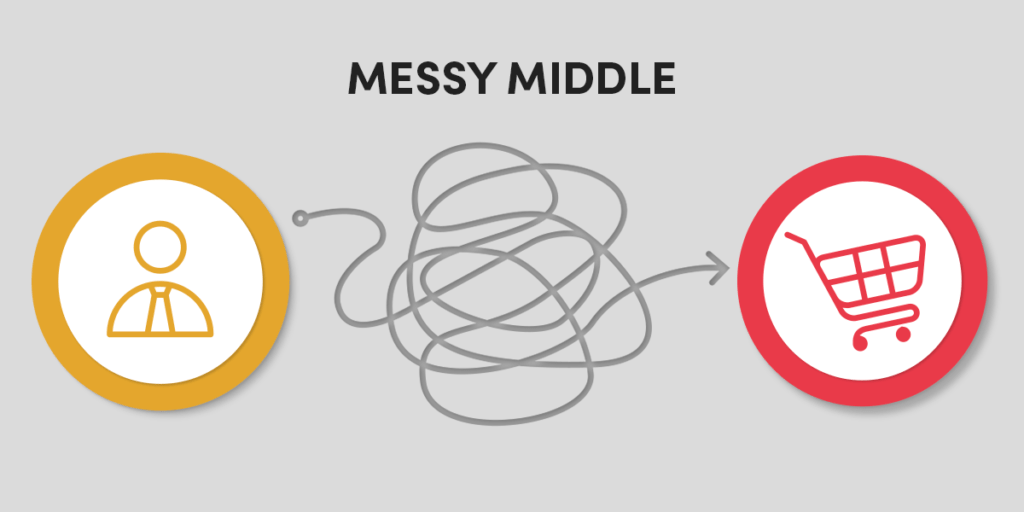
1. The right keyword research & keyword mapping
To get more sales, you need to approach to keyword research looking at the bottom of the marketing funnel. So we are talking about users who are currently in the state of evaluation or purchase, right after they finished their consideration.
Therefore, the focus is on transactional (research) keywords.
You can use different tools to search for keywords:
- Brainstorming
- Ask customers (service)
- Google-Suggest
- Google Keyword Planer (Ads)
- External Tools (Keyword- & SEO-Tools such as SISTRIX or answer the public)
- SERPs (Metadata of competitors)
| Tip: Look into the Google Search Console for organic only keywords, that have high impressions but little clicks. This indicates that Google classifies your page as relevant for these keywords, but not that relevant to give you a top ranking position. Your task is then to find out whether you need to enrich the existing page with further helpful information. Or whether it is even possible to create an own page to target this keyword. |
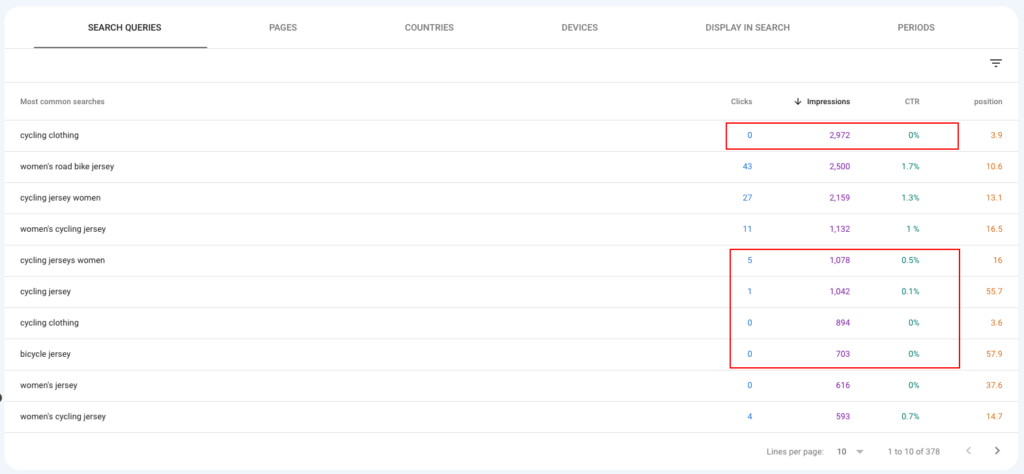
After the research, keyword mapping is as important as the research. Try to ask yourself the following questions:
- Which keywords should be on which page?
- Are the pages unique for Google and the user?
- How should internal links be created?
Like this, you make sure to target the right keywords on the different product or collection pages. You also avoid duplicate content and distribute the link juice wisely. Link juice is important to give specific pages the needed relevance to the search engine. If necessary, you should research on that, too, for example on What is Link Juice and How to Get More of it.
We recommend defining at least one focus keyword per page, a focus keyword is always accompanied by secondary keywords, such as long tail keywords.
With the proper keyword mapping, you may want to adjust your shop structure regarding your navigation.
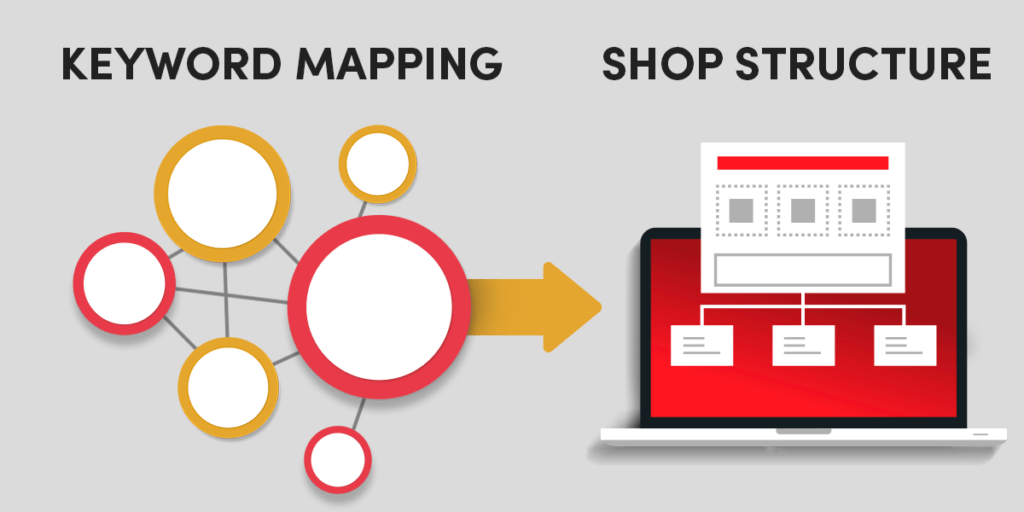
2. On Page SEO
Place the researched keywords on your site. The focus keyword should be in the title and description, URL and the first heading (H1). This method is called exact match. Look also for LSI keywords, which means “latent semantic indexing”: keywords that are generally semantically linked to a given focus keyword. Long tail keywords specifically use the same term as your focus keyword, whereas LSI keywords do not need to include the focus keyword.
Try to use the other keywords in further headings, content, links and so on. Be careful about the right order using headings and use only one H1. You can use one of many tools, such as seobility or SEMrush for looking for On Page issues in your shop.
SEO is no longer only putting keywords on your site and getting backlinks on strong keywords. You need to look at your UX, so the search engine can recognize whether your store is worth getting traffic.
Here are some important factors to consider:
- Time on site: How long users stay on your store
- Pages per session: How well do you guide users through your website structure?
- Bounce Rate: Can you satisfy visitors from Google directly with content in such a way that they don’t turn back in no time?
| Tip: Think about placing a quiz on your site to make users interact with your shop and place one or more given products as a solution to their answers. |
Not only the UX is a big indicator, but also your brand. Nowadays, users are more likely to purchase products when they feel comfortable and do not question the things they perceive.
There are also many guides on how to write the perfect content, so we are not going deep into this right here. Make sure your content is on point and targets what is most important and helpful. Try to use graphics, lists, tables etc. to loosen up your wall of texts.

3. Technical SEO
Technical SEO is the foundation to good performance SEO. A reasonable website structure favors the work. So don’t skimp on keyword research or keyword mapping.
At the start of your SEO optimizations, you may find some technical “handbrakes” that slow down your SEO results.
The technical SEO issues are often the same over any given shop system.
Make sure to adjust these factors correctly:
- robots.txt
- sitemap.xml in the Search Console
- Indexing problems in the Search Console
- Core Web Vitals
- Structured Data
- Product (esp. reviews)
- FAQs
- Breadcrumbs
- Article (for Blog posts)
In the Google Search Console, you can find a lot of data and background information to any of the points above. Maybe your theme already provides this structured data. If not, you may need to update or change the theme you use.
The biggest advantage of technical SEO issues when using Shopify is that you don’t have to worry about the server side of things – as it’s managed by Shopify.
If you want to do a technical crawl of your site, you can use one of many tools to check for errors or issues. Most tools, such as the mentioned ones above, offer On Page and Off Page analysis.
| Tip: Don’t use the tag function for products, collections or blog posts. Unless you code these pages to not be indexed, Shopify creates a lot of pages which most likely provide duplicate content to your site and contaminate the Google index and your crawling budget. |
4. Link building
Even though Technical SEO, On Page SEO, and content are gaining more significance, backlinks continue to be a crucial factor in ranking. Neglecting them in your SEO optimizations would be an oversight and could significantly increase the difficulty of competing effectively.
Backlinks are seen by Google as recommendations. If people are talking about your brand on the internet, this has a positive effect on your rankings.
As we still want to focus on getting more sales, do not place backlinks on top-of-the-funnel-pages. Try to keep an eye on the important linkbuilding factors:
- dofollow vs. nofollow
- anchor text
- relevance
- domain rating/domain authority
- url rating
- linked page
There are different types of link building strategies:
- guest articles/posts
- blogger links
- skyscraper
- broken link building
- unlinked mentions
| Tip: If your budget isn’t sufficient for backlink building services, try the last two strategies. Reach out to sites that have broken backlinks and suggest linking to your page instead. Also reach out to sites that already mention you and ask them for a backlink. |
An essential part of your Off Page strategy is the backlink detox. Use a (free) tool to determine backlinks, such as ahrefs, seobility or backlink tool that are toxic to disavow them through the disavow tool of the Google Search Console. You can also use the Google Search Console to check who is linking to your page.
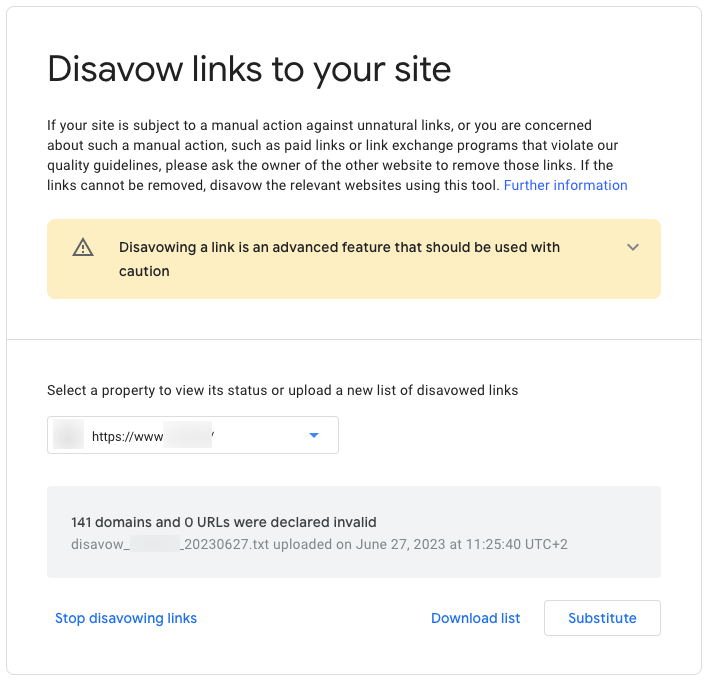
This combined with onsite changes will put you miles ahead of most. The focus, again, is on transactional keywords and the bottom of the funnel to get more sales.
5. Controlling and iterative approach
The most underrated part in SEO is updating and refreshing your given content.
Use the Google Search Console to track your rankings. You can filter for specific keywords or landing pages. If you see some rankings stagnating or falling, take a look at those pages and at your competitors.
Ask yourself the following questions about your competitors to given keywords:
- Which elements do they use and I don’t?
- Which keywords do they use and I don’t?
- Does my content answer the intent of the given keywords?
- Does the user need further information to decide to purchase?
First, check all the On Page and technical SEO issues, then look forward to your Off Page strategy.
Regularly updating your titles and descriptions should be on your agenda. Here is an example of how updating your content can lead to more visibility:
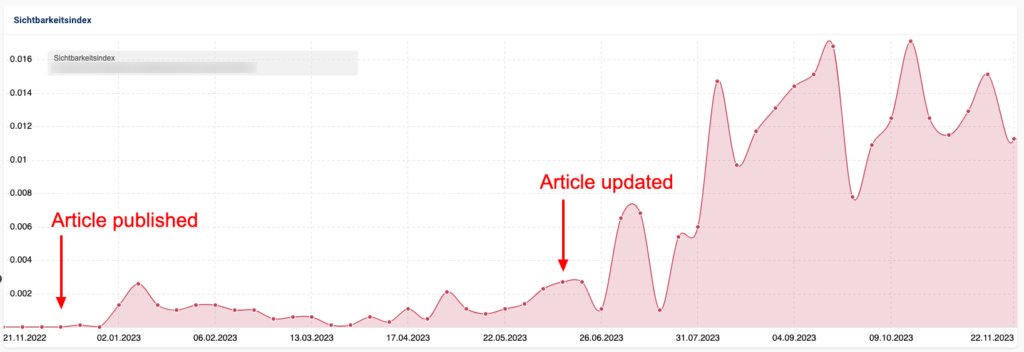
Summary of the best practices
This is how to use the above steps in the best order:
Better Sell Online as your Shopify SEO Partner
If the above optimizations sound good to you, but you do not have the resources to do them by yourself, you are lucky because we are here to help! We are Better Sell Online, a SEO agency specialized in Shopify Shops.
We get your sales relevant keywords (back) into the top 10. Benefit from organic rankings as a competitive advantage. As our daily business we do individual SEO strategies for your shop, regarding On Page, Off Page, Content and Shopify Dev and App know how.
Head over to our website bettersellonline.de and increase your sales with us as your Shopify SEO agency!
Typical Shopify SEO issues to quick-fix
Finally, some helpful tips and tricks we are using in most of our Shopify SEO projects. Be aware that these changes can have a major impact. So be sure of what you are doing when implementing them.
These are improvements that should usually be made directly in your theme code. If you are familiar with the theme code and understand the changes, you can make them yourself.
Brand suffix in SEO title
Most Shopify Themes automatically add the brand as a suffix to your SEO titles. It’s a small line of code which can affect almost any site of your shop. Due to the latest Google updates, the brand keyword will be removed from the page title by Google themselves, so we should not place it in the first hand.
Depending on your theme, search for the following source code. Their for you can go to
Online Store > Themes > … > Edit Code > Layout > theme.liquid:
{%- unless page_title contains shop.name %} – {{ shop.name }}{% endunless -%}
You can either delete it or comment it out:
{% comment %} … {% endcomment %}
Internal product links
Product URLs accessed through a collection get the slug /collections/name-of-collection/.
Depending on your theme, to remove this, search for an a-tag that says “within: collection” and delete that part.
Online Store > Themes > … > Edit Code > Snippets > card-product.liquid:
<a class=”example” href=” {{ product.url | within: collection }}” …>
Exclude “tagged” URLs from being indexed
To check if you have tagged URLs in the index, search Google for
site:YOURWEBSITE.com inurl:tagged
To remove them from the index, go to
Online Store > Themes > … > Edit Code > Layout > theme.liquid:
and add this code snippet:
{% if current_tags %}
<meta name=”robots” content=”noindex, follow”>
{% endif %}
About the author
Henry Auffahrt is CTO & CEO of Better Sell Online GmbH, a web developer and SEO with more than 10 years of experience. His expertise goes from individual SEO strategies over cloud-based architecture to constructing e-commerce shops.
***


